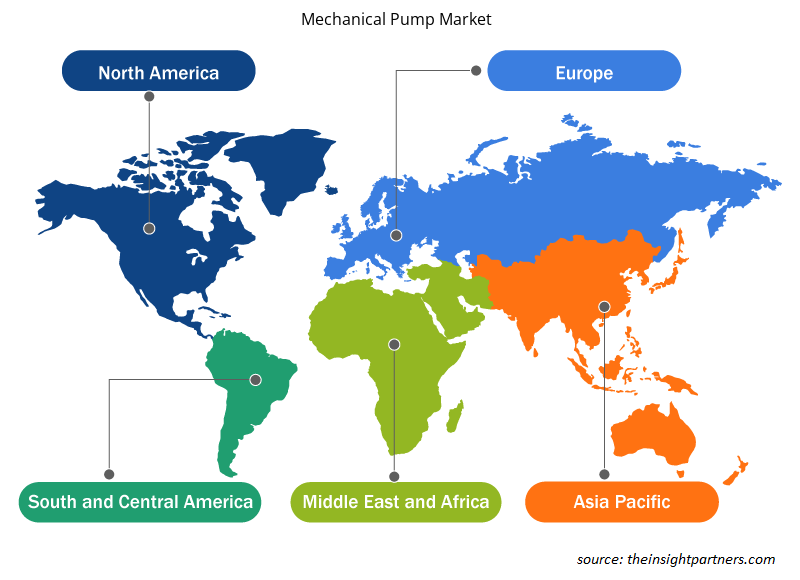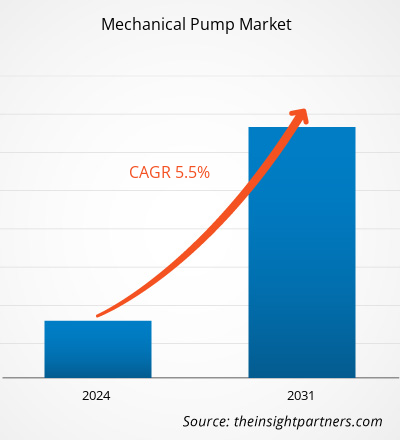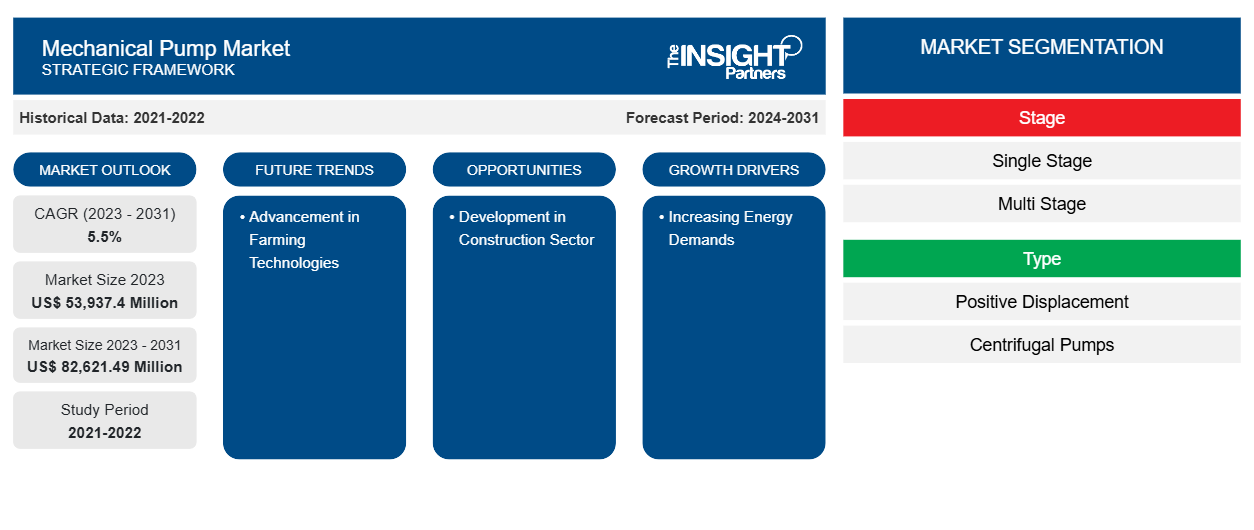Si prevede che la dimensione del mercato delle pompe meccaniche raggiungerà gli 82.621,49 milioni di dollari entro il 2031, rispetto ai 53.937,4 milioni di dollari del 2023. Si prevede che il mercato registrerà un CAGR del 5,5% nel periodo 2023-2031. È probabile che il crescente progresso nelle tecnologie agricole rimanga una tendenza chiave nel mercato.
Analisi del mercato delle pompe meccaniche
Tra questi stakeholder del mercato delle pompe meccaniche figurano agenzie governative, associazioni di settore e organismi di regolamentazione, tra gli altri, come l'Indian Pump Manufacturers' Association (IPMA), la British Pump Manufacturers' Association (BPMA), Europump (l'associazione europea dei produttori di pompe) e l'Hydraulic Institute (HI), tra gli altri. Gli utenti finali delle pompe meccaniche includono settori quali prodotti chimici, petrolio e gas , petrolchimica, estrazione mineraria, produzione di energia, automotive, agricoltura, HVAC e gestione delle acque reflue, tra gli altri.
Panoramica del mercato delle pompe meccaniche
Gli stakeholder chiave nell'ecosistema del mercato globale delle pompe meccaniche includono produttori di pompe meccaniche, agenzie governative, associazioni di settore, enti normativi, fornitori/distributori e utenti finali. Alcuni dei principali produttori di pompe meccaniche inclusi in questo rapporto sono Grundfos Holding A/S, Kirloskar Brothers Limited, KSB SE & Co. KGaA, Ebara Corporation, Sulzer Ltd, Pleuger Industries, The Weir Group PLC, Wilo SE, Tsurumi Manufacturing Co., Ltd. e Xylem Inc. tra molti altri. Oltre a questi attori chiave dell'ecosistema, diversi stakeholder periferici nel mercato globale delle pompe meccaniche svolgono un ruolo fondamentale nel consentire l'adozione di queste macchine tra gli utenti finali e nel promuovere progressi tecnologici per una crescita futura sostenibile del mercato.
Personalizza questo report in base alle tue esigenze
Riceverai la personalizzazione gratuita di qualsiasi report, comprese parti di questo report, o analisi a livello nazionale, pacchetto dati Excel, oltre a usufruire di grandi offerte e sconti per start-up e università
-
Scopri le principali tendenze di mercato in questo rapporto.Questo campione GRATUITO includerà analisi di dati che spaziano dalle tendenze di mercato alle stime e alle previsioni.
Driver e opportunità del mercato delle pompe meccaniche
Aumento della domanda di energia da parte degli operatori di mercato per favorire il mercato
La crescente domanda di energia e la crescente richiesta di forniture energetiche ininterrotte nei settori commerciale e industriale stanno spingendo la domanda di infrastrutture energetiche aggiuntive. L'acqua svolge un ruolo chiave nella generazione di elettricità in queste centrali, poiché viene convertita in vapore per azionare le turbine. Le pompe meccaniche vengono utilizzate per far circolare l'acqua in queste centrali elettriche. A causa dell'aumento della popolazione, dell'industrializzazione e dell'urbanizzazione a livello globale, in particolare nell'area Asia-Pacifico, la domanda di energia sta aumentando a un ritmo elevato. Di conseguenza, diverse centrali elettriche alimentate a combustibili fossili vengono implementate in tutto il mondo. Inoltre, la generazione di energia da fonti di energia rinnovabili è in una fase iniziale e viene principalmente enfatizzata in Nord America ed Europa. Pertanto, la crescente domanda di energia, con conseguente aumento delle attività di generazione di energia, sta stimolando la crescita del mercato delle pompe meccaniche.
Sviluppo nel settore delle costruzioni
Diversi operatori stranieri stanno trasferendo le loro attività di produzione nei paesi in via di sviluppo dell'APAC per raccogliere i benefici dei bassi costi di manodopera, che si prevede stimoleranno ulteriormente l'edilizia industriale. Pertanto, con il costante aumento delle attività di costruzione in tutto il mondo, si prevede che il mercato delle pompe meccaniche crescerà ulteriormente durante il periodo di previsione. La crescita di questo settore è attribuita principalmente all'aumento della popolazione urbana, sostenuto da un aumento dello standard di vita. Inoltre, l'aumento dell'edilizia commerciale, come centri ricreativi, sale cinematografiche, centri commerciali, ospedali, arene sportive ed edifici per uffici, sta ulteriormente stimolando la proliferazione di questo settore. Le economie emergenti stanno adottando varie iniziative per stimolare l'industrializzazione creando ambienti aziendali favorevoli per gli investitori internazionali, oltre a estendere il supporto alla crescita della produzione locale, che si prevede stimolerà la domanda di pompe meccaniche durante il periodo di previsione.
Analisi della segmentazione del rapporto di mercato delle pompe meccaniche
I segmenti chiave che hanno contribuito alla derivazione dell'analisi di mercato delle pompe meccaniche sono fase, tipologia e applicazione.
- In base alla fase, il mercato delle pompe meccaniche è suddiviso in monostadio e multistadio. Il segmento monostadio ha detenuto una quota di mercato maggiore nel 2023.
- In base al tipo, il mercato delle pompe meccaniche è suddiviso in pompe volumetriche e centrifughe. Il segmento delle pompe centrifughe ha detenuto una quota di mercato maggiore nel 2023.
- In base all'applicazione, il mercato delle pompe meccaniche è suddiviso in industriale, commerciale e residenziale. Il segmento industriale ha detenuto una quota di mercato maggiore nel 2023.
Analisi della quota di mercato delle pompe meccaniche per area geografica
L'ambito geografico del rapporto sul mercato delle pompe meccaniche è suddiviso principalmente in cinque regioni: Nord America, Asia Pacifico, Europa, Medio Oriente e Africa, Sud e Centro America.
L'ambito del rapporto sul mercato delle pompe meccaniche comprende Nord America (Stati Uniti, Canada e Messico), Europa (Russia, Regno Unito, Germania, Francia, Italia e resto d'Europa), Asia Pacifico (Corea del Sud, India, Australia, Giappone, Cina e resto dell'Asia Pacifico), Medio Oriente e Africa (Sudafrica, Arabia Saudita, Emirati Arabi Uniti e resto del Medio Oriente e Africa) e Sud e Centro America (Argentina, Brasile e resto del Sud e Centro America). In termini di fatturato, l'Asia Pacifico ha dominato la quota di mercato delle pompe meccaniche nel 2023. Il Nord America è il secondo maggiore contributore al mercato globale delle pompe meccaniche, seguito dall'Europa.
Approfondimenti regionali sul mercato delle pompe meccaniche
Le tendenze regionali e i fattori che influenzano il mercato delle pompe meccaniche durante il periodo di previsione sono stati ampiamente spiegati dagli analisti di Insight Partners. Questa sezione discute anche i segmenti e la geografia del mercato delle pompe meccaniche in Nord America, Europa, Asia Pacifico, Medio Oriente e Africa e America meridionale e centrale.

- Ottieni i dati specifici regionali per il mercato delle pompe meccaniche
Ambito del rapporto sul mercato delle pompe meccaniche
| Attributo del report | Dettagli |
|---|---|
| Dimensioni del mercato nel 2023 | 53.937,4 milioni di dollari USA |
| Dimensioni del mercato entro il 2031 | 82.621,49 milioni di dollari USA |
| CAGR globale (2023-2031) | 5,5% |
| Dati storici | 2021-2022 |
| Periodo di previsione | 2024-2031 |
| Segmenti coperti |
Per fase
|
| Regioni e Paesi coperti |
America del Nord
|
| Leader di mercato e profili aziendali chiave |
|
Densità degli attori del mercato delle pompe meccaniche: comprendere il suo impatto sulle dinamiche aziendali
Il mercato delle pompe meccaniche sta crescendo rapidamente, spinto dalla crescente domanda degli utenti finali dovuta a fattori quali l'evoluzione delle preferenze dei consumatori, i progressi tecnologici e una maggiore consapevolezza dei vantaggi del prodotto. Con l'aumento della domanda, le aziende stanno ampliando le loro offerte, innovando per soddisfare le esigenze dei consumatori e capitalizzando sulle tendenze emergenti, il che alimenta ulteriormente la crescita del mercato.
La densità degli operatori di mercato si riferisce alla distribuzione di aziende o società che operano in un particolare mercato o settore. Indica quanti concorrenti (operatori di mercato) sono presenti in un dato spazio di mercato in relazione alle sue dimensioni o al valore di mercato totale.
Le principali aziende che operano nel mercato delle pompe meccaniche sono:
- CORPORAZIONE EBARA
- Grundfos Holding A/S
- FRATELLI KIRLOSKAR LIMITED
- KSB SE & Co. KGaA
- INDUSTRIA PLEUGER
- Sulzer Ltd
Disclaimer : le aziende elencate sopra non sono classificate secondo un ordine particolare.

- Ottieni una panoramica dei principali attori del mercato delle pompe meccaniche
Notizie e sviluppi recenti sul mercato delle pompe meccaniche
Il mercato delle pompe meccaniche viene valutato raccogliendo dati qualitativi e quantitativi dopo la ricerca primaria e secondaria, che include importanti pubblicazioni aziendali, dati associativi e database. Di seguito sono elencati alcuni degli sviluppi nel mercato delle pompe meccaniche:
- EBARA Corporation Japan (EBARA) ha acquisito il 100% del capitale di Hayward Gordon LP (Hayward Gordon). (Fonte: EBARA Corporation, comunicato stampa, ottobre 2022)
- Grundfos Holding A/S, leader mondiale nelle soluzioni di pompaggio avanzate e nella tecnologia dell'acqua, ha inaugurato oggi il suo stabilimento all'avanguardia in Serbia. (Fonte Grundfos Holding A/S, comunicato stampa, settembre 2022)
Copertura e risultati del rapporto sul mercato delle pompe meccaniche
Il rapporto "Dimensioni e previsioni del mercato delle pompe meccaniche (2021-2031)" fornisce un'analisi dettagliata del mercato che copre le seguenti aree:
- Dimensioni e previsioni del mercato delle pompe meccaniche a livello globale, regionale e nazionale per tutti i principali segmenti di mercato coperti dall'ambito
- Tendenze del mercato delle pompe meccaniche e dinamiche di mercato come driver, vincoli e opportunità chiave
- Analisi PEST e SWOT dettagliate
- Analisi di mercato delle pompe meccaniche che copre le principali tendenze del mercato, il quadro globale e regionale, i principali attori, le normative e i recenti sviluppi del mercato
- Analisi del panorama industriale e della concorrenza che copre la concentrazione del mercato, l'analisi della mappa di calore, i principali attori e gli sviluppi recenti per il mercato delle pompe meccaniche
- Profili aziendali dettagliati
- Analisi storica (2 anni), anno base, previsione (7 anni) con CAGR
- Analisi PEST e SWOT
- Valore/volume delle dimensioni del mercato - Globale, Regionale, Nazionale
- Industria e panorama competitivo
- Set di dati Excel
Report recenti
Rapporti correlati
Testimonianze
Motivo dell'acquisto
- Processo decisionale informato
- Comprensione delle dinamiche di mercato
- Analisi competitiva
- Analisi dei clienti
- Previsioni di mercato
- Mitigazione del rischio
- Pianificazione strategica
- Giustificazione degli investimenti
- Identificazione dei mercati emergenti
- Miglioramento delle strategie di marketing
- Aumento dell'efficienza operativa
- Allineamento alle tendenze normative























 Ottieni un campione gratuito per - Mercato delle pompe meccaniche
Ottieni un campione gratuito per - Mercato delle pompe meccaniche